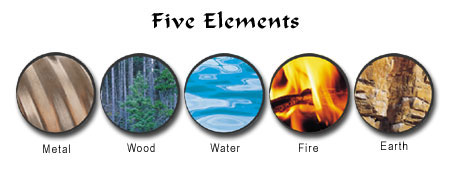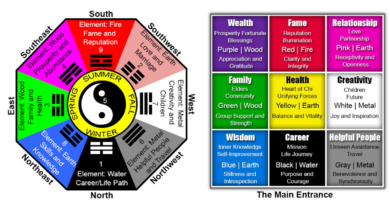FENG SHUI | USING THE ELEMENTS
The five elements in Feng Shui are Wood, Fire, Earth, Metal and Water. These Feng Shui elements interact between themselves in certain ways, either to nurture or to weaken each other as in the Productive and Destructive cycles respectively.

WHY ARE THE FIVE ELEMENTS IMPORTANT IN FENG SHUI?
You need the presence of all five Feng Shui elements in your living space in order to thrive and feel healthy. While it is very important to understand the Bagua and know how to bring the right Feng Shui elements for each specific area, be it with colours, shapes or specific images; it is equally important to know how to strengthen or weaken the presence of a specific Feng Shui element.
For example, consider a fireplace in the East Feng Shui area of a home. After studying the Bagua – the Feng Shui energy map – it is clear that the East area is governed by the “Wood” Feng Shui element. A fireplace, being a “Fire” element item, is too strong for the Wood because Fire burns the Wood, which makes the fireplace an undesirable feature in the East.
 So, does this mean that the house has bad Feng Shui because it has a fireplace in the East? No, it doesn’t. What it does mean, though, is that there is a potential for burnout and stress for people living in this house. Since the East Feng Shui area is the area connected to health and family relationships, and the governing element of East is Wood. Thus, it is important to have a strong and vibrant Wood element in order to bring the desired quality of energy to a home. When the Wood element is weakened, or destroyed by a strong Fire in the East, the quality of energy needed to maintain good health in the home is not produced.
So, does this mean that the house has bad Feng Shui because it has a fireplace in the East? No, it doesn’t. What it does mean, though, is that there is a potential for burnout and stress for people living in this house. Since the East Feng Shui area is the area connected to health and family relationships, and the governing element of East is Wood. Thus, it is important to have a strong and vibrant Wood element in order to bring the desired quality of energy to a home. When the Wood element is weakened, or destroyed by a strong Fire in the East, the quality of energy needed to maintain good health in the home is not produced.
As a fireplace is not easily removed or repositioned, what can be done? This is where the knowledge about the two main cycles of the five Feng Shui elements – Productive and Destructive – is very helpful, as you need to know how to weaken the Fire and bring the desired strength to the governing Wood element.
WHAT ARE THE PRODUCTIVE AND DESTRUCTIVE CYCLES?
There are two main cycles of interaction between the five Feng Shui elements: Productive (cycle of creation) and Destructive (cycle of destruction).
EXPLAIN THE PRODUCTIVE CYCLE.
Here is the summary of the Productive/Creative cycle.
Water nurtures -> Wood nurtures -> Fire nurtures -> Earth nurtures -> Metal nurtures -> Water.

You should use the Productive, or Creative cycle, when you need to strengthen a particular element. For example: You need to strengthen the Wood feng shui element in a specific area: Besides the obvious step of bringing more Wood energy (with plants, wood décor items, colours green and brown, etc); you should also focus on bringing more of the Water element because it nourishes the Wood. You can do that with an actual water feature, such as an aquarium or a fountain, with images of water, mirrors, as well as décor elements in deep blue or black colours in fluid shapes.
EXPLAIN THE DESTRUCTIVE CYCLE.
Here is the summary of the Destructive cycle.
Water weakens -> Fire weakens –> Metal weakens -> Wood weakens –> Earth weakens –> Water.

You should use the Destructive Cycle when you need to weaken a particular element in your environment. For example: If the Water element in a specific area is too strong and you cannot remove the decor element that brings the Water energy – such as, for example, mirrored closet doors in the West area – then you need to weaken the Water element. In order to do that, you will bring the Earth element to put down/absorb the excess Water energy. Decor-wise, you can do any of the following: bring several big to medium size earthenware vases, have a beige rug with a predominantly square pattern, paint the walls in a light yellow or beige colour and/or bring art with a strong earth element presence.
EXPLAIN WITH AN EXAMPLE THE USE OF PRODUCTIVE/DESTRUCTIVE CYCLES IN FENG SHUI?
Now that you understand the basics of the productive and destructive cycles of the five elements, let’s get back to the example of a fireplace in the East area and see how you can remedy the situation by using the newly acquired knowledge about the two main cycles of the Feng Shui elements.
Your goal: To strengthen the Wood element and weaken (destroy) the Fire element in the East Feng Shui area of a home.
Your strategy: You need to bring the Water element as Water nurtures the Wood and at the same time puts down the Fire. In practical terms, you can hang a big mirror above the fireplace, which will bring the desired energy of the Water Feng Shui element. You can also choose to go for a round or oval shape mirror (Metal element shape), as Metal nurtures Water, or go for a frame in a blue or black colour (colours of the needed Water element.) You can also choose to bring the Water element with strong water energy art, an actual water feature or paint the East wall in a water element colour.

Of course, optimum Feng Shui solutions are always the ones that work best with your decor and compliment it, rather than detract from it. You can create a harmonious Feng Shui home in any decor style and for any taste as long as you understand the Feng Shui energy that each decor item adds to your home. The best way to bring Feng Shui elements into your home is in their natural state. For example, if you need more Wood, a lush green plant would be the best cure. Second best would be a piece of wood furniture or artwork with lush green colors. Buying items from your community and knowing where they come from will bring you even better energy. The more you play with the five Feng Shui elements theory and see how it applies to each area of your home, the sooner you will know how to decorate your house in a way that nurtures and supports the health and well-being of your family.
This post describes the usage of the five elements in Feng Shui. Each of these elements is associated with specific colours and shapes. When using these elements as remedies, they can be used as such or can be represented by their colours and shapes. For more information on this, go to:
IRelated Topics:
- Feng Shui
- Feng Shui Principles
- Feng Shui Principles Applied To A Proposed Building
- Feng Shui Principles Applied To An Existing Building
If you found this post useful, all it takes is a simple click on the “pin it” “like,” “share,” “tweet,” or Google+ buttons below the post. Thank you!




By reading this article you can get a beettr understanding about how the five elements of Feng Shui are connected to the eight compass directions and how you can use the elements to improve the energy in your house. Thanks
Hi Samreen,
Thank you for the appreciation.
Admin